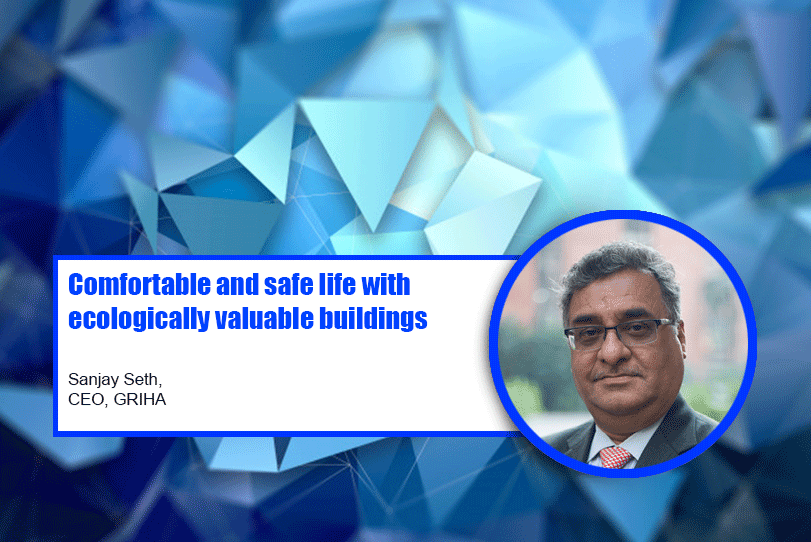The majority of natural disasters around the world can be attributed to anthropogenic climate change fuelled by over consumption – adopting a mind-set of frugality towards resource consumption.
Talking about the increasing concerns over quality buildings, Sanjay Seth, CEO, GRIHA Council mentions of creating sustainable building designs that can address the quality over consumption of resources and balance the climate conditions.
Current and upcoming market trends in green buildings
With greater awareness and sensitisation major strides are being made in technology that can potentially change the way we design and operate green buildings. Communicable smart metering and monitoring systems, capable of tracking energy and water consumption through web hosted portals are increasingly prevalent. These systems can report hourly data reporting in near-real-time, illustrate energy mix breakdown and consumption patterns, establish water consumption patterns from various sources, set consumption limits and are able to draw comparisons with historical trends and benchmark data. In keeping with GRIHA’s motto of “What gets measured gets managed”. This increased availability of real-time consumption data has engendered a growing emphasis on the operations and maintenance aspect of green buildings no matter how sustainable a building may have been in its design and construction it can only remain that way if it is operated responsibly and maintained at optimum functionality.
The O&M phase sees practices such as recycling and air quality enhancement taking place and there has been a marked shift toward educating building operators and occupants in the effective implementation of sustainable strategies. Other trends that are coming to the forefront include Life Cycle Cost (LCC) and Life Cycle Analysis (LCA). Performing a Building Life Cycle Analysis is currently the most reliable way to evaluate the ustainability of a building and its adoption by building professionals is a response to the backlash against vague eco-labelling and increased citizen awareness about how the built environment affects climate change. Life Cycle Costing involves economic analysis directed at all costs related to construction, operation, and maintenance of a building over time. Together, LCC and LCA can allow effective tracking of the benefits conferred by the implemented technology.
Impacts of Covid-19 on the green building space
At the end of the day, we look to our homes to shelter us from the storm outside. Our homes are where we seek security and sanctuary, and that is precisely why one can anticipate heightened awareness and an increased demand for green living spaces in the days to come. Self-isolation, indoor disinfection, natural ventilation, and community management have become everyday by words when it comes to combating the pandemic, and working from home has emerged as the new normal overnight. Green buildings help ensure that these living spaces we now occupy for a greater part of the day are better equipped to cater to our comfort and safety, and provide us with environments in which we can thrive and be productive. GRIHA rated projects are required to manage concentrations of pollutants such as formaldehyde, benzene, volatile organic compounds and particulates during both construction and occupancy stages. Smoking is either prohibited or strictly regulated within premises and buildings are rewarded for incorporating essential services such as grocery shops and ATMs within the campus, if they are not to be found within short walking distance.
With increasing acceptance of the fact that the majority of global issues can only be addressed by transitioning to a more sustainable way of life, now more than ever it is imperative for consumers to realise the benefits of reducing energy and water consumption, managing waste and capping environmental pollution. The majority of natural disasters around the world can be attributed to anthropogenic climate change fuelled by over consumption – adopting a mind-set of frugality toward resource consumption while simultaneously optimising efficiency of our systems is the only path that can lead us toward a sustainable tomorrow. Green buildings are designed to inherently ensure or reinforce these parameters – daylight and heat ingress are balanced, while thermally comfortable indoor conditions are mandated without sacrificing efficiency. Each of these factors eventually contribute toward both the longterm wellbeing of occupants as well as a reduction in the environmental footprint generated by the building.
Significance of green buildings in India
There is a general misconception in India that green buildings are more expensive in terms of capital cost. This unfortunate perception took root in the early days of the industry in India when compliance with foreign rating systems would require large scale import of expensive material. Although certain elements of a green building (for example, UPVC windows) might appear to be more expensive than alternatives at the outset, these costs can easily be offset through value engineering, which in itself is an indispensable part of building green. With insulated walls, UPVC windows, provision for daylighting and solar panels, and the energy requirement for lighting and heating, ventilation and air conditioning decreases proportionately; systems may be designed and installed in accordance with the reduced demand, saving on capital costs. If one incorporates rainwater harvesting and the treatment of waste water, water bills can also subsequently be reduced in addition to boosting groundwater levels in the region through recharge.
The life of a building is well over half a century. Through efficient consumption of resources, a green building will continue to be an asset to the owner and occupants throughout its life, especially in the face of ever-increasing costs of electricity and water.
Any ground-breaking idea needs time to take root, and currently only a miniscule part of India’s built infrastructure can currently be considered “green”. However, one must understand that that bulk of our infrastructure is yet to be built, and there are huge opportunities to make sure that we are moving forward on the correct path toward a sustainable future. Significant advances in that direction have already been made – from modest beginnings in 2005, GRIHA’s built footprint across India now stands at over five and a half million square feet.
Creating a sustainable and safe environment for both commercial and residential space
The GRIHA rating system takes a holistic approach toward sustainable action intended to mitigate climate change and a significant aspect of that is a reduction in GHG emissions from the construction and operation of India’s building stock. The construction sector, being one of the significant contributions to the nation’s GDP, is responsible for about 22 percent of the total annual emission of carbon dioxide that is generated by the Indian economy. The Government of India in response to Conference of the Parties (COP) decisions 1/CP.19 and 1/CP.20 recognized Green Rating for Integrated Habitat Assessment (GRIHA) as a national tool, to evaluate GHG reduction from habitats. Given India’s commitment under the Paris Agreement and the Kigali Agreement, the surge in the usage of HVAC systems in India needs to be coupled with the potential to embed energy efficiency features and use of cost-effective low GWP refrigerants. The National Building Code has requirements on the use of zero-ODP and low-GWP refrigerants. GRIHA makes this mandatory. In addition, GRIHA projects on average target 30-50 percent reduction in energy consumption during the design phase and up to 40 percent reduction in end use energy consumption, enabling massive subsequent reduction in carbon emissions. There is currently a 60:40 ratio between commercial and residential projects registered with GRIHA.
Advantages of BFI tool in the onset of increasing number of buildings
Building Fitness Indicator (BFI) is a social initiative by GRIHA Council to assist people in tackling the COVID-19 crisis. BFI is a self-assessment tool that allows organisations to measure the preparedness of workplaces in terms of preventing exposure to COVID-19. The larger intent is to provide a certain degree of assurance to the occupants regarding their safety and comfort within their work premises when business activities resume as before.
The tool has a checklist to assess the measures adopted by organisations and building managers to ensure hygiene and ventilation in workplaces. The resulting analysis appears as a reading on a meter, indicating whether or not the organisation is prepared to combat COVID-19. The tool provides guidance based on the standard practices followed across the globe (as prescribed by organisations such as WHO, OSHA) and in India (by MoHFW and ISHRAE) to prevent workplace exposure to COVID-19.
BFI has consciously been designed as a tool, and not as a rating or a certification. The guidance provided is advisory and informational in nature, and has a set of simple yet effective measures to combat the current crisis. The end-goal is to ensure the health and well-being of employees while enhancing the productivity of organisations and, ultimately, the economy of the nation.
Dealing with the financial losses
The ongoing pandemic has exposed fault lines in our economy. There is no denying the fact that we must learn to live under the shadow of COVID-19 for the foreseeable future. This would mean re-opening of businesses in a phased manner while ensuring social distancing and personal hygiene. Under such circumstances, buildings that have been certified to provide secure, efficient environments will enhance the demand for such spaces. A building with efficient resource consumption, and consequently lower operating costs, takes on added appeal in these trying times – especially when combined with healthier and consistently comfortable interiors.
Sanjay Seth, CEO, GRIHA
Cookie Consent
We use cookies to personalize your experience. By continuing to visit this website you agree to our Terms & Conditions, Privacy Policy and Cookie Policy.














